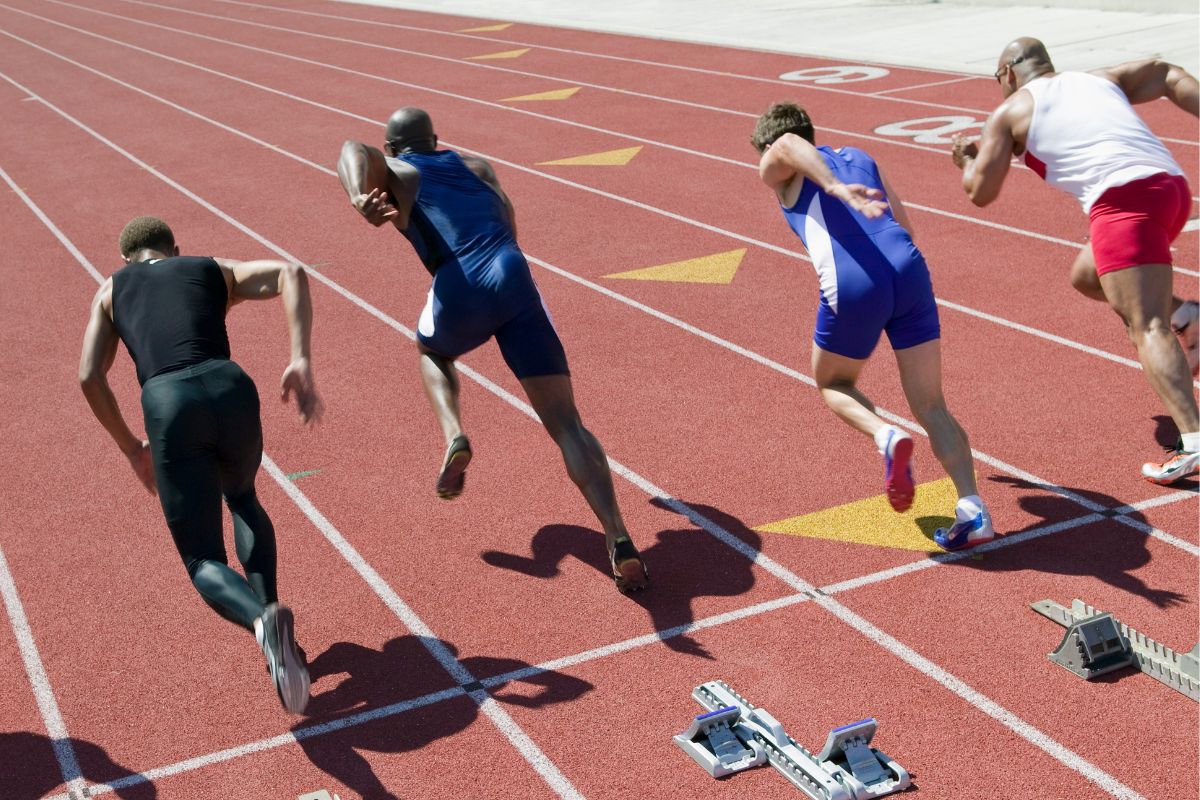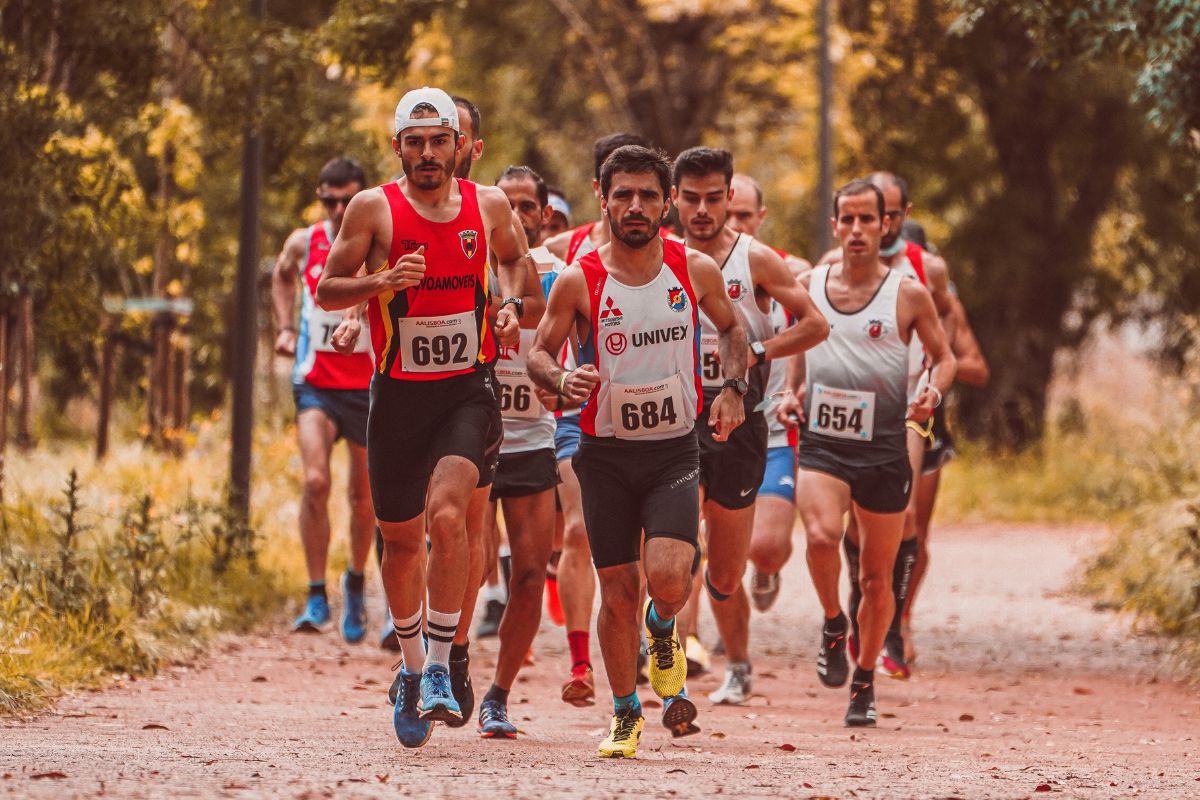The 100-meter race is one of strength and ferocity. It takes a lot of practise to become a proficient sprinter.
The fastest sprinters are capable of completing the distance in less than 10 seconds.
The world’s top athletes have times that are exceedingly difficult to match.

Being swift by nature is insufficient for success. Devoted instruction and focused practise are required.
You won’t need to worry, though, as this tutorial will show you how to sprint the 100m and help you improve your times.
Some individuals possess the innate capacity to run quickly. Others must invest time and effort into developing it, though.
The following points are something to remember if you wish to increase your speed:
- Your speed will improve as your power does.
- Your overall speed will increase if your stride length is better.
- Your overall speed will increase if you can increase your leg turn over.
- Your overall speed will increase as your speed endurance increases.
- The suggestions listed below provide rather rapid fixes so you can sprint more quickly for 100 metres.
The suggestions listed in this article provide rather rapid fixes so you can sprint more quickly for 100 metres.
Warm-Up
The purpose of your warm-up is to promote quicker muscle contractions and get you ready for your workout.
Make sure you have a lot of blood circulating so that oxygen can reach the muscles that are contracting while you move.
5 minutes of easy cardio should be completed to begin your warm-up routine.
Our sprinters typically choose to jog around the track, but cardio machines like the treadmill and rowing machine are also acceptable.
Avoid stationary stretching whenever your muscles are cold. Instead, engage in mobility exercises and dynamic stretching.
Place an emphasis on fluid motions and active stretching. You can accomplish your warm-up objective by using these kinds of stretches and drills.
Technique Exercises: When executed properly, technique drills can directly translate to your sprinting acceleration and top speed.
Perform three to four accelerations while moving forward for 20, 30, 40, and 50 metres from the starting line. With each acceleration, the intensity should be raised.
Exercise Intervals
Sprint training consists primarily of intervals. Since the 100-meter sprint is among the shorter sprints, you should avoid running for too long.
To give an overview, once pre-season is complete, we hardly ever run further than 400 metres.
Your training may vary in volume and intensity. You want your training load to correspond to the event’s level of intensity.
This often entails performing sprints with a high degree of effort (at least 90%), followed by a full or nearly full recovery between sets.
Athletes will recover fully or nearly fully if they are operating at 90 percent of their maximum capacity.
But there are additional training factors to take into account.
For instance, if the amount of training is considerable, each run’s intensity will be under 90% with shorter rest intervals.
Boost Your Capacity For Speed
One of the most important aspects of the 100-meter sprint is how the body naturally begins to slow down as the race progresses.
It’s important to maintain your maximum speed for a long period. Usain Bolt excels at keeping and preserving his high speed.
You must prepare your body to maintain the maximum speed for a long period before the 100-meter race.
You must therefore perform speed-endurance repetitions across distances of 120, 150, and 200 metres. Even some sessions can be extended to 300 or 400 metres.
Say you complete the 100 metres in 14 seconds. You can perform 200-meter sprints at intervals of 32 seconds. Your objective is to maintain the speed over that distance.
You can perform it with walk-back recoveries, but it’s preferable if you do it with a split of 30 to 60 seconds. then begin the following repetition.
You should see that your capacity to maintain your technique for longer throughout future tournaments will enable you to run faster.
Become More Explosive
Exercises that involve plyometrics can help you with this. Your muscles’ suppleness and ability to generate power will both improve as a result.

Your reaction time off the ground will be quicker the more flexible you are. You will run more quickly the more energy you have available to you.
Start by performing a few of the following powerful exercises.
- Skipping – This is a straightforward one. Just get a fast skipping rope, and at least two times a week, skip at least 100 times.
- Single leg bounds – Similar to a power run where you only use one leg, this. 3 sets of at least 8 reps should be performed.
- Single leg hops – Hop with one leg for strength and distance. 3 sets of at least 8 reps should be performed.
- Double leg jumps – These exercises, also referred to as frog jumps, assist your glutes and quads gain explosive strength. Avoid doing these workouts right before a competition because it puts a lot of stress on the body.
Also, make sure to keep your toes raised. Running with their toes pointed down is another mistake new runners make when they first start out.
Running is tough because of this. Keep doing them. The knee drive, stride length, and leg speed turnover will all benefit from this.
Strength Workouts
To optimize your sprinting potential, strength training is a crucial part of your workouts. There are other forms of strength training than weightlifting in the gym.
One rapid strength training workout and one reactionary strength training session should make up the two weekly strength training sessions.
Boost the power of your abdominal and core muscles – This will be the first thing you should do because your core strength will be a factor throughout each exercise and drill you perform.
Squats, leg lifts, and knee raises are the greatest place to begin an exercise routine. Squats can be performed with small weights that are gradually increased over time.
Leg extensions can help you build up the strength in your hip flexors – This is crucial since running causes your hip flexors to swiftly wear out.
To strengthen your quadriceps, use a leg extension machine.
You only need to perform 15 reps of a moderate weight. You will have the necessary strength to perform the additional hip flexor exercises after this.
Single leg raises – You have a choice of resting on the ground or hanging. Straighten your leg out to a 90-degree angle, then lower it to the floor. 15 to 30 repetitions are appropriate.
Double leg raises – You may do this while hanging or lying down. (Hanging, ideally. Lift your legs to a 90-degree angle, then lower them while maintaining tension in the muscle. 3 sets of 15 repetitions each.
Race-Day Planning
Let’s go over the steps you must take to get ready for race day. At the finish line, getting this properly can make all the difference.
Pre-Race Planning
- Get a good night’s rest the night before.
- Eat a filling breakfast before the race
- Keep hydrated.
Warm-Up
We advise you to start warming up 45 to 1 hour before your race’s planned start time.
On the day of the event, there will likely be a lot of waiting, so doing this will guarantee that you have enough time to get psychologically and physically ready.
Additionally, it allows you to use the restroom, finish up any last-minute preparations, and go to the athlete waiting area.
The warm-up you conduct before a workout could be the same as your actual warm-up, but without the technique drills.
Setting Up The Foundation
Make sure your configuration is consistent each and every time you set up your beginning blocks.
Avoid varying or assuming your block positions. The secret is consistency.
- Use two foot measurements from the start position for the front pedal when determining your pedal positions.
- The rear pedal should be positioned 3 feet back from the starting line.
- Set the blocks at an angle of about 45 degrees.
Pre-Race Procedure
Once the blocks are set up, a good method is to accelerate from blocks 2 and 3, increasing the distance between each acceleration by about 10 to 30 metres.
Every athlete has a personal regimen that aids in helping them unwind and into the zone. This might be a pre-race ritual of some kind, a visualisation technique, etc.
When you first start out, don’t stress too much about this part of the plan.
It will improve as you gain more race experience. It’s crucial to maintain calm and try to soothe your nerves.
How To Sprint A 100m
Block starts might be a little challenging to execute, especially if you’re a beginner. Practice is crucial during training for this reason.
Start on all fours in front of the blocks, then coil backwards into them as if you’re a spring about to spring.
Put only part of your foot on the pedal. The forefoot’s tip should be contacting the floor.
Raising your hips and slightly extending your knees when the official indicates to set.
Bring your hips up till they are taller than your shoulders. To ensure that it all stays in a neutral position, maintain a straight line.

Avoid leaning forward to the point when you cross the line.
By doing this, you will shift the weight from your feet to your hands. You want your feet to be tense so you can accelerate quickly from the pedals and leap forward.
Once the movement is complete, extend the front pedal lower leg and hip to make a 45-degree angle with the ground.
During the initial steps when driving low, your centre of mass should go before your foot.
Be aggressive when you step off the starting line and drive your feet hard into the floor with each stride. You will simultaneously drive your arms in opposite directions, back and forth.
You will start to gain energy and increase your speed as you accelerate. Every time you take a step, try to lengthen your stride.
Making an effective adjustment to an upright straight running position throughout the first 30 to 50 metres is the next task.
This should be done gradually so that you may rise up from the energy of your strides organically.
Avoid rising swiftly to your feet. You will decelerate and lose momentum more quickly as a result of this.
The moment the torso is upright, the gliding phase starts. Here, you’ll need to use your leg strength and sprinting technique to keep a broad but manageable stride length.
Try to maintain your calm. This prohibits tensing the jaw or hunching the shoulders.
Body tension at a high level will simply cause you to tyre more quickly. You can only sustain your top speed for a brief period of time once you’ve reached it.
Because of this, accelerating properly can drastically affect your race.
Although deceleration cannot be prevented, using proper sprinting technique will help you retain your top speed.
Final Thoughts
Now that you know how to sprint the 100 metres faster, you must understand how to make it even faster.
Each stage has a different range when running the 100m, and you can accomplish these ranges as you acquire skill and as your speed, stamina, power, and coordination advance.
It will take time and effort to develop your 100-meter race; it won’t come suddenly. In fact, mastering the 100-meter dash could require more than one season of practise.
If you can’t figure things out the first time, don’t give up. To truly develop a sense for the ideal 100 metres, it requires time and practise.
- Can Dogs Run Faster Than Humans? (Running With Your Furry Friend) - October 4, 2022
- 10 Doggie Fun Runs You Will Love [Ultimate Guide] - October 4, 2022
- What Are Division Results In Running? - October 4, 2022








